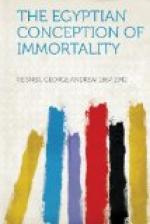The earliest belief in immortality is that which is shown to us by the burial customs of the primitive race,—the prehistoric Egyptian race.
About 4500 B.C. we find the Egyptian race was just emerging from the Stone Age. All the implements and weapons found are of flint or other stone. The men of that time were ignorant of writing, but show a certain facility in line drawings of men, plants, and animals. We have found thousands of their graves which all show the same idea of death. Each person was buried with implements, weapons, ornaments,—no doubt those actually used in life,— with a full outfit of household pots and pans, and with a supply of food. The man was dead, but he still needed the same things he used in ordinary life. By a fortunate chance we have even recovered bodies accidentally desiccated and preserved intact in the dry soil. These bodies do not show any trace of mutilation, mummification, or any other preparation for the grave except probably washing. The dead body was simply laid on a mat in the grave, covered with a cloth and a mat or a skin, and then with clean gravel. But with it was placed all those things which the man might need if his life were to go on in some mysterious, unseen way, as life went on among those on earth. Possibly his relations as in later times brought offerings of food to the grave, but here even the dry soil of Egypt fails to furnish positive evidence. All this shows a plain simple belief in the persistence of the life of a man as distinguished from the body —a belief widely prevalent among primitive people. It contains nothing unusual, and is probably perfectly explicable psychologically by means of dreams.
There is little or no change in this underlying belief to be observed in the burial customs of the Egyptians during the late predynastic period. Copper weapons and implements succeed stone in the graves. All those objects in whose manufacture the new tools are used show changes of technique and form. It is even curious to note that some of the older stone and flint objects, some of the older pots and pans, are still made as a matter of tradition. The importance of this is not to be overlooked. For centuries men had used flint knives and they had baked their bread in flat mud saucers set in the ashes. For the centuries these flint knives and these cakes with their saucers had been placed in the graves. Gradually metal knives and better bread pans displaced these more primitive objects in daily life; but the older primitive objects were still placed in the graves as a matter of tradition.




